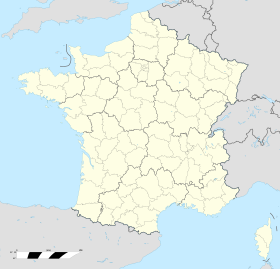Ouvrage Four-à-Chaux
| Ouvrage Four-à-Chaux | |
|---|---|
| Part of Maginot Line | |
| Northeast France | |

Block 6 and the array of anti-tank rails
|
|
| Coordinates | 48°59′49″N 7°47′49″E / 48.99694°N 7.797°E |
| Site information | |
| Controlled by | France |
| Open to the public |
Yes |
| Condition | Preserved |
| Site history | |
| Materials | Concrete, steel, deep excavation |
| Battles/wars | Battle of France, Lorraine Campaign |
| Ouvrage Four-à-Chaux | |
|---|---|
| Type of work: | Large artillery work (Gros ouvrage) |
|
sector └─sub-sector |
Fortified Sector of the Vosges └─Langensoultzbach |
| Work number: | O 600, Ouvrage E |
| Constructed: | 1930–1938 |
| Regiment: | 165th Fortress Infantry Regiment (RIF) |
| Number of blocks: | 8 |
| Strength: | 19 officers, 491 enlisted |
Ouvrage Four-à-Chaux is a gros ouvrage of the Maginot Line, located in the community of Lembach, France, in the Bas-Rhin département. Four à Chaux was adjoined by petit ouvrage Lembach and gros ouvrage Hochwald, and faced the German frontier as part of the Fortified Sector of the Vosges. A "four à chaux" is a lime kiln in French, and the ouvrage was located in the area of a limestone quarry and kiln, which operated until 1939. Four-à-Chaux was bombarded by the invading Germans in late June 1940 during the Battle of France with both aerial attacks and artillery bombardments. Four-à-Chaux survived to surrender at the end of the month. Block 1 was destroyed by the Germans before retreating in the face of American advances in 1945. During the 1950s Four-à-Chaux was renovated and reoccupied against a perceived threat from the Soviet Union. It fell out of use in the 1970s, and is now operated as a museum.
The site was surveyed by CORF (Commission d'Organisation des Régions Fortifiées), the Maginot Line's design and construction agency; Lembach was approved for construction in July 1931. The gros ouvrage was intended to receive a second 75mm gun turret in a second phase of construction, never pursued. Due to its compact arrangement, Four-à-Chaux did not receive an electrified internal rail system; the garrison pushed carts on the rails between the blocks. The fort also features an artesian well.
Four-à-Chaux is a position of medium importance on the Line, covering an area of 26 hectares, 4.5 km of subterranean galleries and six combat blocks. The ouvrage comprises eight blocks, with six combat blocks and two entries. The significant change in level between the combat blocks and the ammunition entrance required an inclined gallery immediately after the ammunition entrance. There is a 24-meter elevation difference between the ammunition entrance and the higher personnel entrance. In contrast to most gros ovrages in northeastern France, Four-à-Chaux's internal railway system was not electrified. A drainage gallery was built to function as an emergency exit from the area of the caserne.
...
Wikipedia

